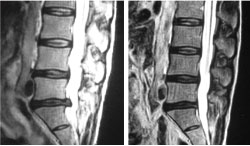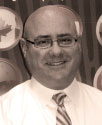
A Call for Chiropractic: New research means the time is ‘now’ for non-surgical spinal decompression
By Gary Dixon
Features Clinical Patient CareTrue non-surgical spinal decompression (N-SSD) for patients with back
pain due to disc pathology is, and should remain, the eminent domain
of the chiropractic profession. As musculoskeletal experts, there is no
other group in health care that is more qualified than chiropractors to
treat patients suffering from chronic low back pain. Therefore, it
makes sense that the profession embraces and makes this non-invasive
technology routinely available to the appropriate patients.
 |
| Pre-and post-N-SSD MRI for Mr. Laurent Goldstein – used here with patient’s permission. |
True non-surgical spinal decompression (N-SSD) for patients with back pain due to disc pathology is, and should remain, the eminent domain of the chiropractic profession. As musculoskeletal experts, there is no other group in health care that is more qualified than chiropractors to treat patients suffering from chronic low back pain. Therefore, it makes sense that the profession embraces and makes this non-invasive technology routinely available to the appropriate patients.
In the September 2007 issue of Canadian Chiropractor the various non-surgical spinal decompression technologies were reviewed. However, since the publication of this article new clinical data in favour of non-surgical spinal decompression has been published by members of the medical community. This new data has been as much a cause for celebration as a cause for concern with chiropractors utilizing this technology. The celebration is obviously the continued validation of the efficacy, and science, of the technology in treating chronic back pain patients. However, the concern is, as medicine continues to investigate and publish its findings on non-surgical, spinal decompression, what role will chiropractic have in treating chronic back pain patients with this technology? To alleviate this concern – and understand what medicine will contribute to this technology and, ultimately, to the chiropractic profession – it is important to understand how medicine has approached the question of N-SSD.
The History
It is no secret that chiropractic often comes under attack, for its methods and practices, from the medical community. This has also been the case when chiropractors utilize non-surgical spinal decompression in their practice. This condemnation originates from the medical community’s criticism of the quality of the non-surgical decompression studies conducted prior to October 2005.

In 2005, the Cochrane Collaboration published a report entitled, “Traction for low-back pain with or without sciatica (Review).” In this review, a search of all literature published up to November 2004 was conducted, and subsequently analyzed, including an article specifically dealing with one particular company’s non-surgical decompression device. The authors of the Cochrane Review expressed their dismay regarding the quality of these studies by stating, “…most available studies have methodological problems, with the potential for biased results.” They go on to offer guidance for future research by suggesting that, “Any future research … be carried out according to the highest methodological standards to avoid potential bias.”
In 2006, another study – this time carried out by supporters of the chiropractic profession – entitled, “Systematic Literature Review of Spinal Decompression Via Motorized Traction for Chronic Discogenic Low Back Pain” reviewed and analyzed all literature published between 1975 and October 2005. The authors of this study expressed many of the same concerns that were discussed in the Cochrane Collaboration article by noting, “Because the overall quality of studies was low and the patient groups were heterogeneous – e.g., grouped by symptom duration and diagnoses – a meta-analysis was not appropriate and a qualitative review was undertaken.” As a result, the authors concluded, “The evidence for the efficacy of motorized spinal decompression for discogenic lumbrosacral back pain remains inconclusive. Scientifically more rigorous studies with better randomization, more complete control groups, uniform selection criteria, evidence-based diagnostic measures, and standardized outcome measures are needed to identify the best responders to this conservative intervention.”
In 2007, Dwain M. Daniel, of the Parker Research Institute, Parker College of Chiropractic, published an article titled, “Debate, Non-surgical spinal decompression therapy: does the scientific literature support efficacy claims made in the advertising media?” Although the majority of the studies discussed in this article are based on one specific manufacturer’s N-SSD unit, the author does state that his article is not a systematic review of the literature. Nonetheless, he does come to many of the same conclusions mentioned above regarding outcome measures, study design, bias, etc.
The Idea
Even though there is criticism regarding the quality of the studies conducted prior to October 2005, the data from these studies, along with strong anecdotal evidence, do show promising results in treating back pain with non-surgical spinal decompression. However, mediocre studies and anecdotal evidence is not enough to
satisfy any critic. With this in mind, a conscious decision was made to prove the efficacy and science of N-SSD by forming an international medical advisory board to provide guidance on developing and implementing short- and long-term clinical trials. The rationale was, if medicine can ultimately prove the efficacy of N-SSD, then the likelihood that any chiropractor who utilizes this technology will come under attack for its proper use is virtually eliminated.
The Call
Clinical and case studies that have been published since October 2006 have definitely generated interest among medical doctors. However, because this technology has not yet been accepted by the insurance industry, this interest has, for the most part, been purely academic. In addition, most of the material that has been |published lists at least one chiropractor as co-author, indicating the technology can never be the exclusive domain of the medical doctor. The time is now to aggressively embrace this technology that enhances the chiropractor’s ability to successfully treat those patients with disc pathologies.
Canada is still in the emergent stage with respect to N-SSD, with the chiropractor being the first to adopt the technology. In fact, acceptance of this technology, within the chiropractic profession, has grown rapidly since Dr. Terry Yochum published his case report on Mr. Laurent Goldstein, the owner of Brican Corp., a Canadian business that services and supports the chiropractic profession. (See Mr. Goldstein’s pre-and post-MRI images, above.)

To date, use of the N-SSD is still dominated by the chiropractic profession. Dominance will prevail as long as the profession does not abdicate its right to treat patients with the technology. Dr. Yochum said it best during his lecture at the 2008 Parker Seminar in Las Vegas when he told his audience, “Years ago in the ’80s when MRI emerged, I answered a question, ‘Does chiropractic need to be utilizing Magnetic Resonance Imaging (MRI)?’ I stated, ‘If chiropractic does not investigate or utilize MRI, then MRI will leave chiropractic behind. Perhaps prophetically I offer the following, ‘If chiropractic does not investigate, or utilize and/or research, true non-surgical spinal decompression, then this technology will leave chiropractic behind.”’
Gary Dixon is the VP of sales and marketing for Axiom Worldwide. He has over 20 years of domestic and international health industry experience. Mr. Dixon may be contacted at: VP@Axiomworldwide.com .
Print this page